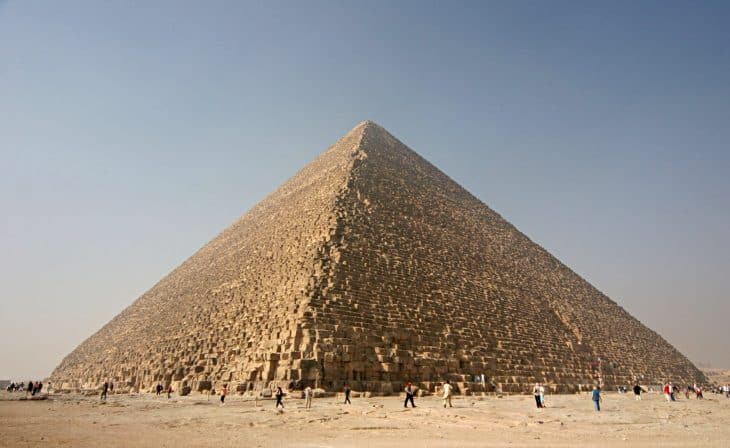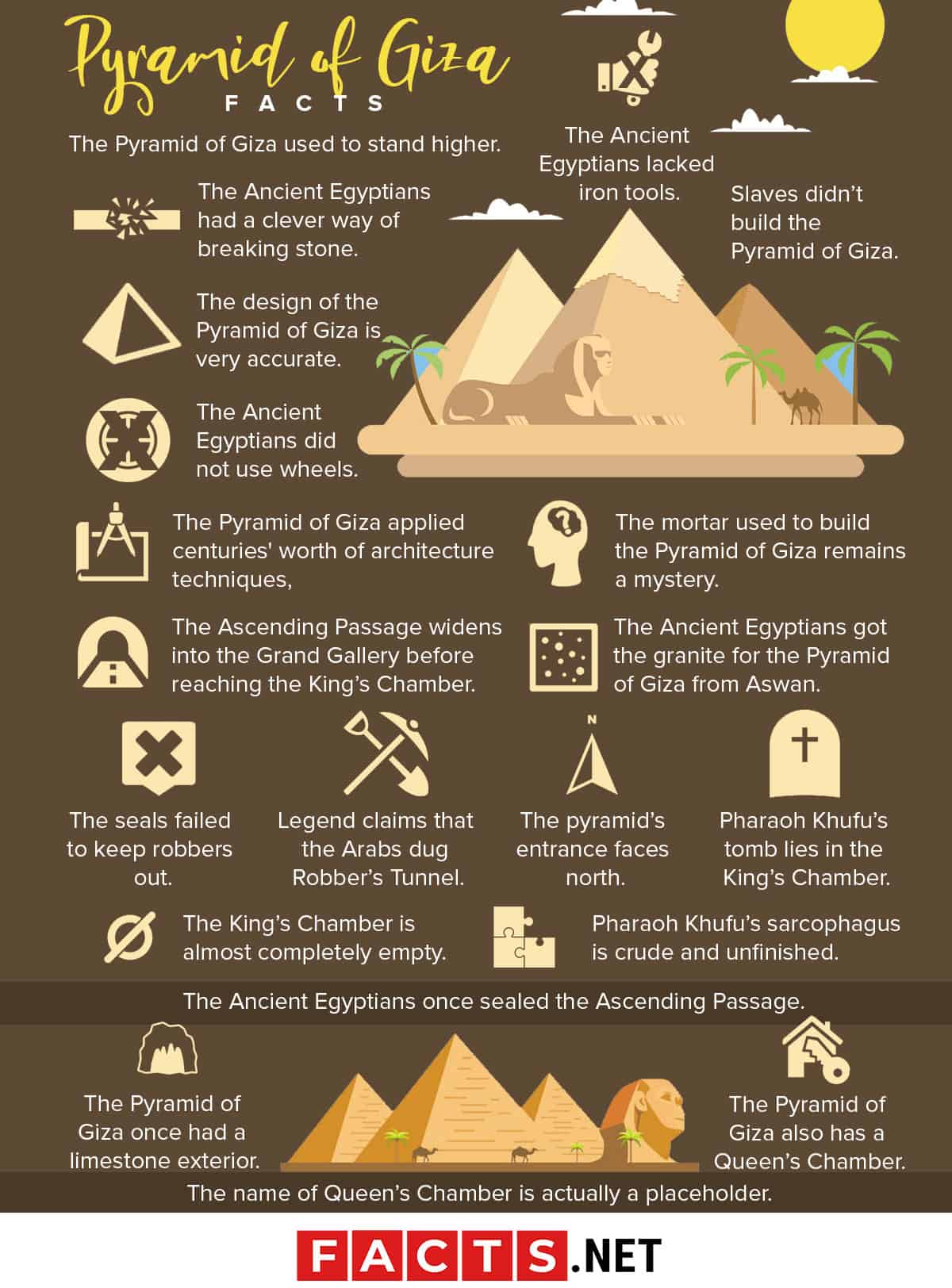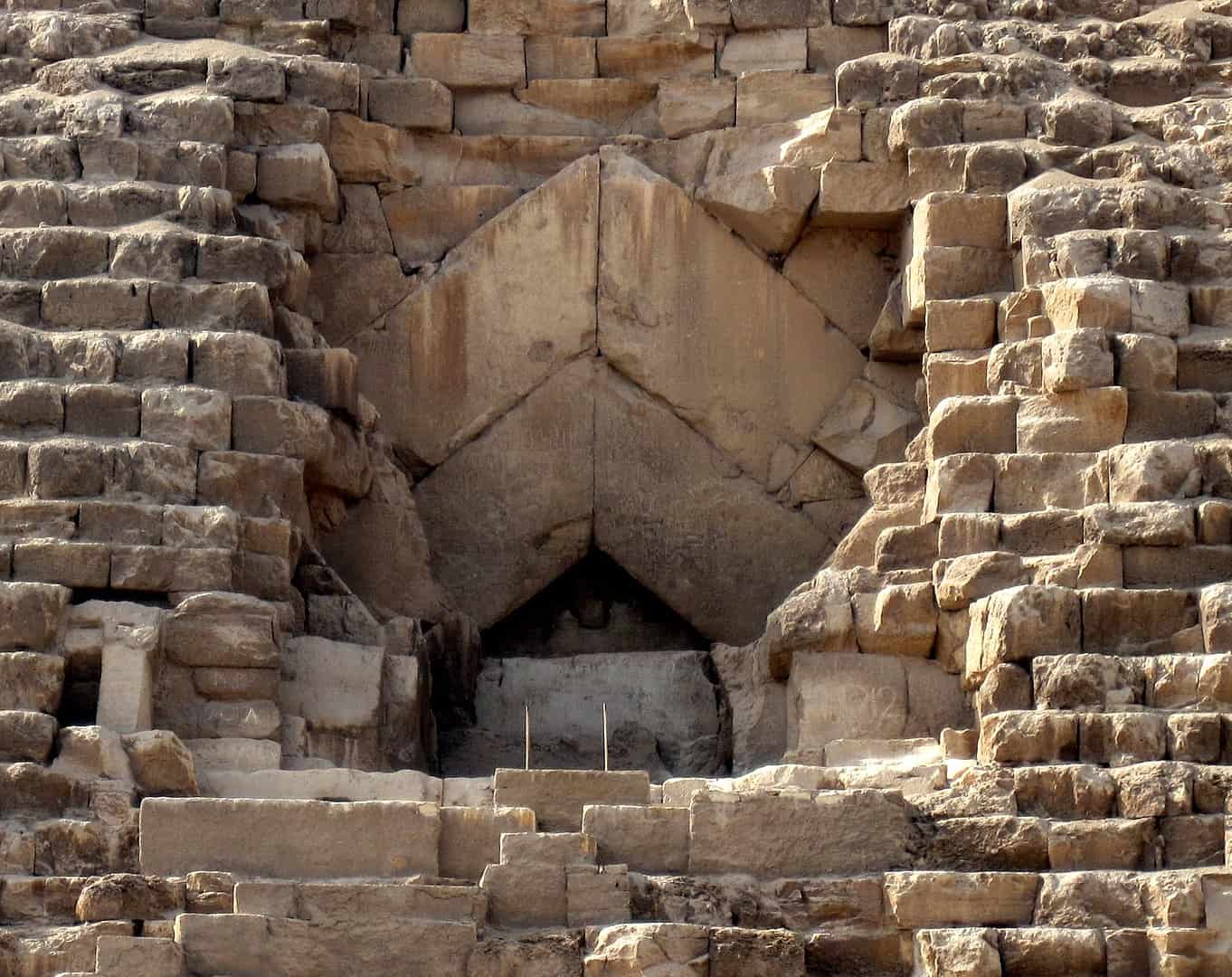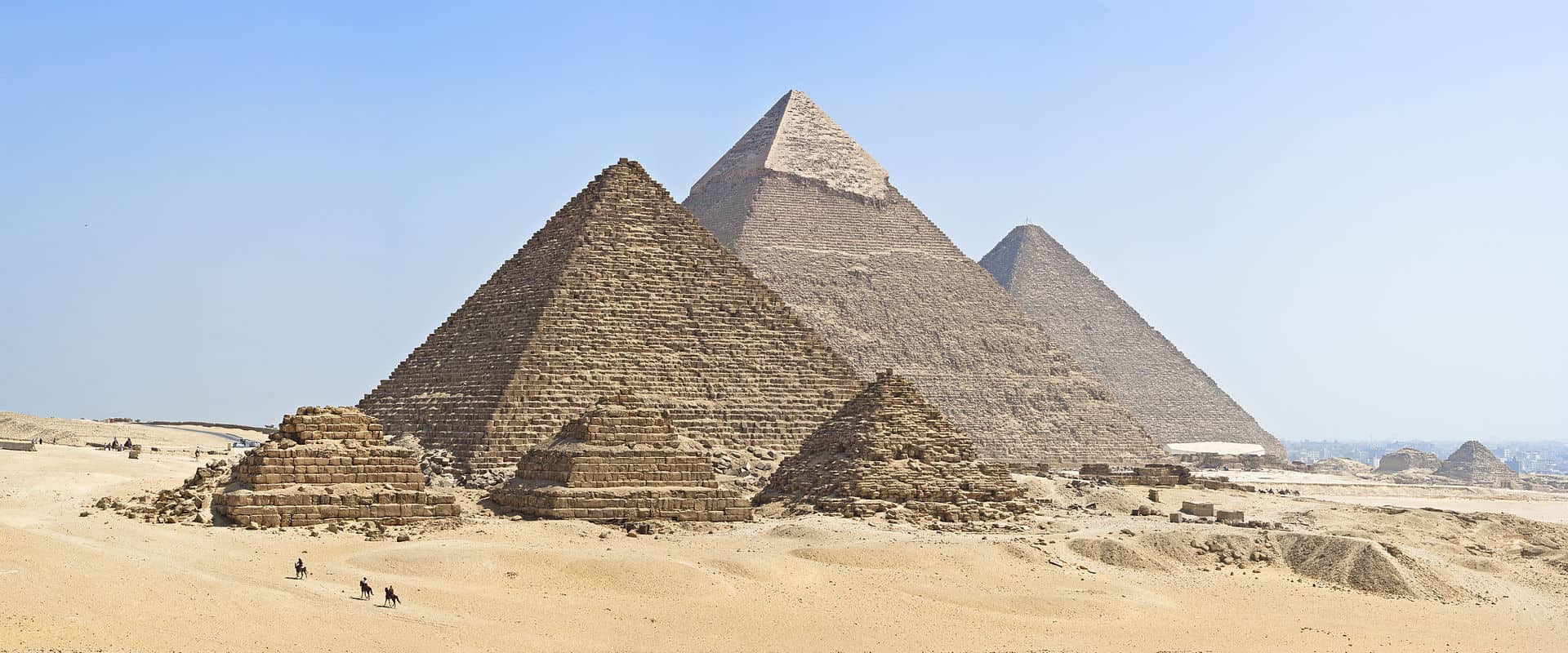
Centuries after its construction, the Pyramid of Giza stands as the last of the Seven Wonders of the Ancient World. Surviving long after its people, the Great Pyramid teaches us a lot about Ancient Egypt- but not without unsolved mysteries. Learn more about the wonders of this ancient landmark with these Pyramid of Giza facts.
- The Pyramid of Giza stands 138.8 meters high.
- It has a volume of 2.58 million cubic meters.
- Each side of the pyramid’s base measures 230.34 meters long.
- 2.3 million blocks of stone make up the pyramid.
- The heaviest of the pyramid’s stone blocks weigh up to 80 tons.
- The Pyramid of Giza dates back to the mid-2nd Millennium BC, during the Egyptian Old Kingdom.
- It’s part of a series of pyramids built by the pharaohs of Egypt’s Fourth Dynasty.
- Pharaoh Khufu was the pharaoh the Egyptians built the pyramid for.
- Khufu’s vizier, Hemiunu may have also designed the pyramid as its architect.
- Construction on the Pyramid of Giza started in 2580 BC.
- It took 20 years to finish the pyramid, in 2560 BC.
- At its completion the Pyramid of Giza was the tallest building in the world, and would hold that title for 3,800 years.
- By the time of the Egyptian Middle Kingdom, looters had already broken into and robbed the pyramid.
- The Egyptian New Kingdom built their royal tombs in the Valley of the Kings because of the pyramids’ vulnerability to looters and grave robbers.
- The pyramid lost its title as the tallest building in the world to England’s Lincoln Cathedral in 1311 AD.
- The Pyramid of Giza and the Great Pyramid of Giza refer to the same building.
- The pyramid weighs an estimated 6 million tons.
- Limestone and granite make up the stone that, in turn, make up the pyramid.
- The base of the pyramid is only around 15 mm from becoming perfectly flat.
- The corners of the pyramid’s base all point to 1 of the four directions of the compass.
Pyramid of Giza Facts Infographics

The Pyramid of Giza applied centuries' worth of architecture techniques,
In 27th Century BC, the Ancient Egyptians built the first pyramid at Saqqara. Rather than our mental image of pyramids, the Step pyramid resembled the ziggurats of neighboring Mesopotamia more. As the Ancient Egyptians built more pyramids, they learned how to develop their design.
Eventually, this resulted in the Bent Pyramid which had a steeper angle at the top. Finally, the Egyptians constructed the Pyramid of Giza with uniformly-sloping sides. All pyramids built afterward followed the standard set by the Pyramid of Giza.
The Pyramid of Giza used to stand higher.
According to records, the Pyramid of Giza originally rose to a height of 146.7 meters, which is almost 10 meters taller than it is today. Some theorize that the reduced height results from the loss of the pyramid’s gold-plated capstone. However, some skeptics still debate whether the capstone really existed or not. How’s that for mysterious Pyramid of Giza facts?
The Pyramid of Giza once had a limestone exterior.
As impressive as the Pyramid of Giza may seem in the present day, you’re only looking at the pyramid’s core or base. Unlike the capstone, scholars have been able to pinpoint why the pyramid’s exterior disappeared.
Specifically, an earthquake in the 14th Century caused severe damage to the pyramid. In the aftermath, most of the pyramid’s lining broke off. Instead of repairing the pyramid, the people repurposed the limestone for other structures in Cairo. Today, none of the casing remains on the pyramid, though some of its rubble still lies on the ground outside.
The Ancient Egyptians got the granite for the Pyramid of Giza from Aswan.
To build the Pyramid of Giza, the Egyptians had to transport granite 800 km from Giza. Fortunately, the river Nile allowed for the easy shipment of this raw material.

The Ancient Egyptians had a clever way of breaking stone.
Without iron tools, the ancient Egyptians had to improvise a lot. To break apart stone, the Egyptians would cut grooves into the rocks, inserting wooden wedges into the indents. Afterwards, the Egyptians would soak them in water. As the wood absorbs the water, it expands and breaks the stone. The Ancient Egyptians then finished the broken stone into blocks ready for use in construction. How’s that for ingenious Pyramid of Giza facts?
The Ancient Egyptians lacked iron tools.
This made it very difficult for them to work with hard stone like granite. While they had copper and bronze tools, these materials were simply too soft to cut granite. As a result, the Egyptians had to use tools made from harder rocks such as dolomite to cut granite. They would also rub powdered quartz against the blocks to smooth them out, much like how we use sandpaper today. These alternatives became crucial to the process of building the Great Pyramid.
The Ancient Egyptians did not use wheels.
While scholars knew that the Ancient Egyptians relied on the Nile to transport the pyramid’s materials, they debated how the people maneuvered these heavy loads on land. Eventually, they discovered the Ancient Egyptians simply put the stone on sleds, dragging them overland to the construction site.
Slaves didn’t build the Pyramid of Giza.
While Biblical tales and stories from Ancient Greece suggest that slaves built the Great Pyramid, this is actually not the case. Historians have since concluded that Pharaohs made peasants work on the pyramid to provide them income during the dry season. Throughout the process, the peasants received pay, food, and housing. More than that, they also saw it as a religious act, which helped earn them a place in the afterlife, through building the Pharaoh’s final resting place.
The mortar used to build the Pyramid of Giza remains a mystery.
To bind the pyramid’s stones together, the Ancient Egyptians used gypsum treated with heat. However, archaeologists still wonder how the Ancient Egyptians found enough wood to burn as fuel for the process. An old theory suggested that Ancient Egypt tore down its few forests for fuel, but the evidence no longer supports this. As such, scientists today still study various theories to find the truth behind this mystery.

The design of the Pyramid of Giza is very accurate.
The pyramid’s sides only have an error in their dimensions of around 58 mm. The ancient Egyptians also built the Giza Pyramid Complex to point up to certain stars at night. Together with the precise fit of the pyramid’s stones, it shows a level of architecture and engineering comparable to 21st Century design. How’s that for admirable Pyramid of Giza facts?
The pyramid’s entrance faces north.
The Pyramid of Giza’s entrance stands around 17 meters above the ground and the pyramid’s base. Through the entrance, a tunnel called the Descending Passage leads straight down into the pyramid. Following this path, another tunnel called the Ascending Passage points upward.
The Descending Passage itself continues for 105 meters, reaching under the pyramid and the ground level. This path ends in an unfinished underground chamber, which is believed to be the original tomb for Pharaoh Khufu. However, the pharaoh may have changed his mind, which explains why the Ancient Egyptians left the chamber unfinished.
The Ancient Egyptians once sealed the Ascending Passage.
After the pharaoh died and assumed his resting place in the pyramid, archaeologists believe that the Egyptians sealed off the Ascending Passage. Upon its discovery, three blocks of granite closed the passage, each measuring 1.5 meters thick.
The seals failed to keep robbers out.

Despite the advanced engineering of the pyramid, breaking and entering through the outer entrance turned out easy enough. The seals were more difficult to get past, but thieves still found their way around it. Tomb robbers simply dug their own tunnel through the pyramid, which Egyptologists appropriately call the Robber’s Tunnel.
This self-made tunnel runs through 27 meters of the pyramid before reaching the Ascending Passage past its blocking stones. Surprisingly, the Robber’s Tunnel became the usual tourist’s route to enter the pyramid as well.
Legend claims that the Arabs dug Robber’s Tunnel.
According to the legend, the Arab Caliph al-Ma’mun wanted to enter the pyramid in 820 AD. Unable to find the entrance, he had his men dig the Robber’s Tunnel into the pyramid. However, scholars have since refuted this legend, as research shows that the Robber’s Tunnel is actually much older.
The Ascending Passage widens into the Grand Gallery before reaching the King’s Chamber.
At 8.6 meters high and 47 meters wide, the Grand Gallery dwarfs the Ascending Passage’s 1.1 meters of height and 2 meters of width. While the gallery’s purpose remains unclear to archaeologists today, they do have theories. One common theory suggests that the Grand Gallery once housed Ancient Egyptian astronomers who made sure that the pyramid aligned with the constellations above. How’s that for curious Pyramid of Giza facts?
Pharaoh Khufu’s tomb lies in the King’s Chamber.
The King’s Chamber is about 10 meters wide from east to west, while from north to south it’s only 5 meters wide. Two shafts go through the north and south walls of the chamber, leading to the pyramid’s exterior. Scientists once believed that these shafts allowed certain stars to become visible from the King’s Chamber, but they’ve since discarded the theory.
Another discarded theory proposed that they’re meant as air shafts, though modern custodians installed air fans in them for just that reason. Today, experts agree that the shafts were actually meant to lead the Pharaoh’s soul to the heavens.
The King’s Chamber is almost completely empty.
The only thing in there is actually just the pharaoh’s sarcophagus. Egyptologists think without any doubt that tomb robbers had long since stolen everything inside the chamber. Those included not just the pharaoh’s funeral offerings of treasure, weapons, armor, clothing, and religious items, but also his coffin and mummified body as well. Now that’s one of the sadder Pyramid of Giza facts.
Pharaoh Khufu’s sarcophagus is crude and unfinished.

In stark contrast to the smooth and refined finishing of the surrounding room, the Pharaoh’s sarcophagus lies an unfinished work. Egyptologists now believe that the original sarcophagus somehow got lost while on the way to the pyramid. A common theory suggests that it got lost while in transit on the river. Short on time, a new sarcophagus was then brought to the pyramid but left unfinished when the pharaoh died and needed a burial.
The Pyramid of Giza also has a Queen’s Chamber.
The tunnel to reach it branches off from the Ascending Passage just before it reaches the Grand Gallery. It goes through the pyramid until it reaches the exact midpoint between the north and south faces of the pyramid. The Queen’s Chamber measures about 6 meters wide from north to south, and 5 meters from east to west. It also has a pointed roof, standing about 6 meters high at its highest point.
The name of Queen’s Chamber is actually a placeholder.
Archeologists at the time gave it that name since they assumed only the pharaoh’s queen could share his pyramid. However, Egyptologists admit there’s no evidence for such an assumption. Much like the King’s Chamber, the Queen’s Chamber is completely empty. As a result, scholars also question whether the Queen’s Chamber was even a tomb in the first place.
The Queen’s Chamber has shafts of its own.
Like the King’s Chamber, the Queen’s Chamber has one shaft each in the north and south walls of the chamber. Scientists at first thought they served the same purpose as the shafts of the King’s Chamber, but they soon learned otherwise. In 1872, an archaeologist studying the shafts found they didn’t lead to any of the pyramid’s outer faces. Centuries later, scientists still don’t know what the shafts are for.
Scientists have sent robots into the Queen’s Chamber’s shafts.
In 1992, German engineer Rudolf Gantenbrink led an expedition into the mysterious Queen’s Chamber. Similar expeditions took place later, first in 2002, and then again in 2011. The robots found doors with elaborate copper handles at the ends of the shaft, and while unable to get far, they found the other side of the doors finished and finely-worked. This led scientists to think there’s a very important reason for the shafts in the Queen’s Chambers.
Scientists also discovered a massive empty space at the heart of the pyramid.
In 2017, scientists discovered a massive chasm on top of the Grand Gallery, which they called the Big Void. To this day, no one has been able to determine its purpose. Most scientists think it’s just a construction space formerly used to help build the pyramid, but other scientists disagree. Some believe that the Big Void must have served or still serves a different purpose.
Temples once stood outside the Pyramid of Giza.
The Pyramid Temple once stood on the east side of the pyramid, but today only the basalt pavement remains. There’s also the Valley Temple, the ruins of which lie buried under the modern village of Nazlet el-Samman.
A trio of pyramids stands on the south side of the Pyramid of Giza.
Aside from the three pyramids, scientists also found the remains of a fourth one gravely damaged by time. Scholars refer to this set of pyramids the Queens’ Pyramids, though they’ve only discovered the tomb of Hetepheres I, sister-wife to Pharaoh Sneferu, and Pharaoh Khufu’s mother. However, no one knows where the body is. 
Photo by KennyOMG from Wikipedia
More tombs lie around the pyramid.
Aside from the tombs inside the Great Pyramid, scientists have since located other tombs in the surrounding fields. The East and West fields housed the bodies of lesser royals, including wives, sons, and daughters of Pharaohs for three dynasties.
The workers also had their own tombs near the pyramids.
Of course, they’re not nearly as elaborate as those of royalty. However, these laborers’ resting places also had tombs in solid buildings made from brick, with simple tomb offerings of beer and food. Scientists consider this as evidence that the workers who built the pyramids were, in fact, not slaves, but paid laborers respected for their skills and hard work. Now, there’s one for historic Pyramid of Giza facts.
Scientists also discovered pits for boats around the pyramid.
While they discovered docks for boats, archaeologists did not locate the actual vessels. Scientists believe that the boats either got looted or destroyed over time. However, they did find the shattered remains of a boat inside a pit in 1954.Professional shipbuilders studied the remains, eventually reconstructing the design. The result was a 44-meter long boat, which now stands inside a specially-designed museum on top of the restored pit. How’s that for interesting Pyramid of Giza facts?

The Wall of the Crow surrounds the pyramid complex.
Outside this wall, scientists found the ruins of a town believed to once house the workers and their families. Further study also revealed that in addition to workers, soldiers and sailors also lived in the town. They also discovered that these soldiers and sailors continued to live in the town long after work on the pyramids finished. Scientists believe that this resulted from the utility of the port on the Nile, which stayed useful even after the pyramids’ completion.
The Giza Pyramid Complex largely fell out of use after the New Kingdom.
That said, the Ancient Egyptians never abandoned it. Maintenance on the pyramids continued, and services at the temples nearby also continued. Even as late as the 26th Dynasty, a monumental stone pillar at Giza mentions Pharaoh Khufu and his Queen Henutsen by name.
Was this page helpful?
Our commitment to delivering trustworthy and engaging content is at the heart of what we do. Each fact on our site is contributed by real users like you, bringing a wealth of diverse insights and information. To ensure the highest standards of accuracy and reliability, our dedicated editors meticulously review each submission. This process guarantees that the facts we share are not only fascinating but also credible. Trust in our commitment to quality and authenticity as you explore and learn with us.
